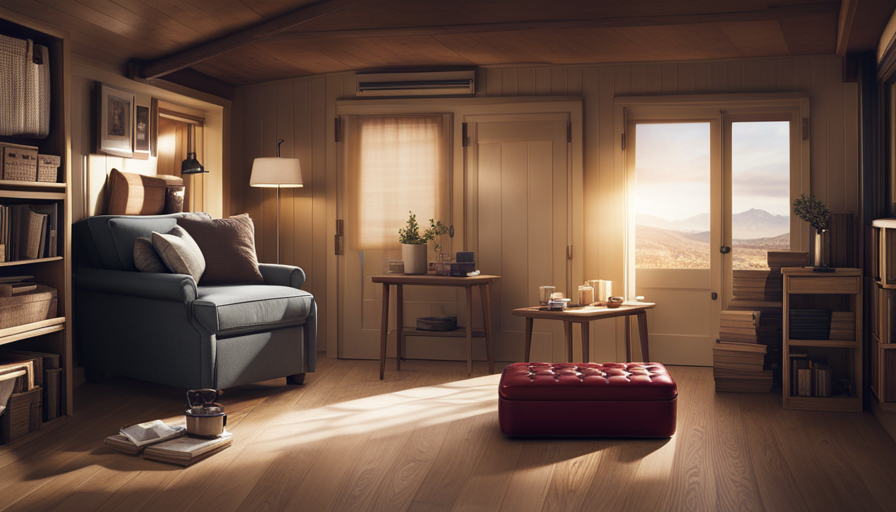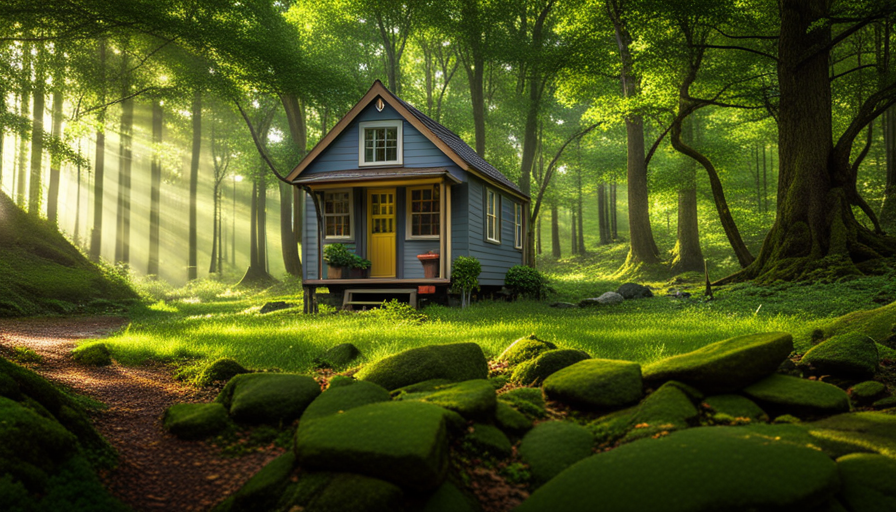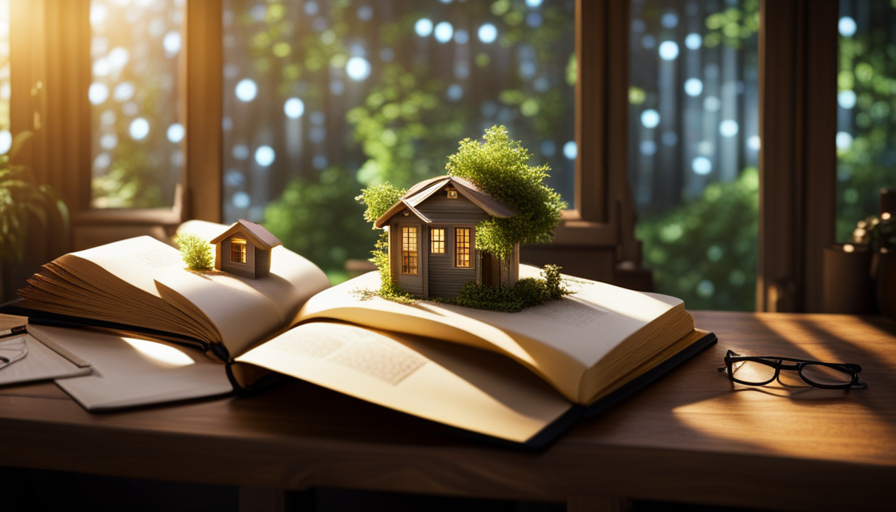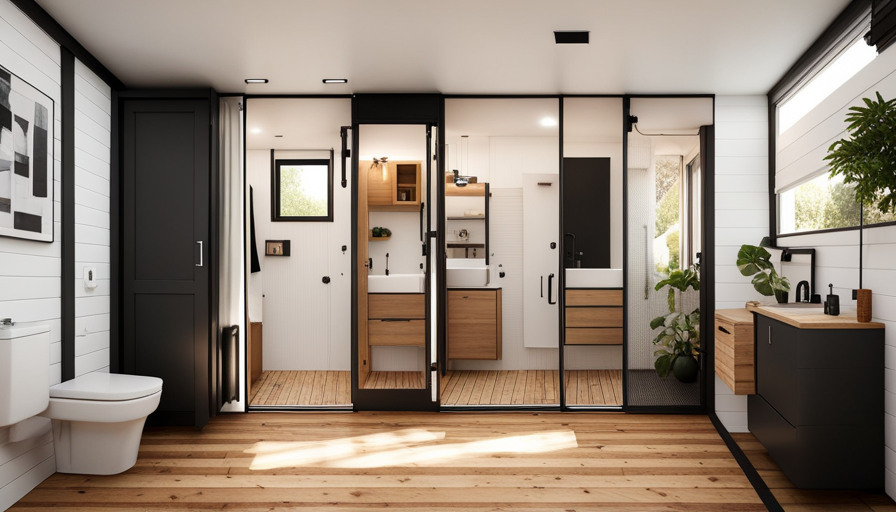Residing in a small home might initially appear challenging because it necessitates reducing your belongings and parting with numerous items. Nonetheless, through meticulous preparation and structuring, dwelling in a compact area can indeed be comfortable and joyful.
One common objection to living in a tiny house is the lack of storage and functionality. But fear not! In this article, I will outline the essentials to keep when living in a tiny house, ensuring that you have everything you need without cluttering your space.
From multi-purpose furniture and storage solutions to efficient kitchen, bathroom, and cleaning essentials, I will provide you with a comprehensive guide to maximize your limited square footage.
Additionally, I will address the importance of keeping personal mementos and sentimental items, as they add a touch of personality and warmth to your tiny home.
So, let’s dive in and discover the essentials that will make your tiny house feel like a cozy and organized sanctuary.
Key Takeaways
- Downsizing and careful planning are necessary when living in a tiny house.
- Multi-purpose furniture and storage solutions are essential for maximizing space.
- Compact appliances and versatile cookware are crucial for a small kitchen.
- Minimalist wardrobes and efficient bathroom essentials are recommended for a tiny house.
Multi-purpose furniture and storage solutions
When living in a tiny house, it’s essential to maximize space by investing in multi-purpose furniture and storage solutions that seamlessly blend functionality and style. Space-saving furniture is a game-changer in a small living space. From sofa beds that can transform into a comfortable sleeping area to foldable tables that can be tucked away when not in use, these pieces are designed to make the most of limited square footage.
Additionally, creative storage solutions are key to keeping a tiny house organized and clutter-free. Utilizing vertical space with wall-mounted shelves and hooks helps to free up valuable floor space. Multipurpose storage ottomans and coffee tables with hidden compartments provide extra storage without sacrificing style. These smart furniture and storage solutions create a streamlined and efficient living environment, maximizing every inch of space.
Now let’s move on to essential kitchen items.
Essential kitchen items
When it comes to living in a tiny house, having compact appliances is essential. They take up less space while still providing all the necessary functions.
Versatile cookware and utensils are also crucial in a small kitchen as they can be used for multiple purposes, saving both space and money.
With the right combination of compact appliances and versatile cookware, cooking in a tiny kitchen can still be enjoyable and efficient.
Compact appliances
One interesting statistic about compact appliances in tiny houses is that they can save up to 50% more energy compared to traditional appliances. This is a significant advantage for those who are looking to live a more sustainable and eco-friendly lifestyle. Compact appliances, such as space saving refrigerators, microwaves, and dishwashers, are specifically designed to fit seamlessly into small spaces without sacrificing functionality. These energy efficient gadgets not only help to reduce electricity usage, but they also take up less space in the kitchen, allowing for more storage and countertop area.
Here is a table showcasing some popular compact appliances that are perfect for tiny houses:
| Appliance | Size | Energy Efficiency | Features |
|---|---|---|---|
| Compact Refrigerator | 2.5 cubic feet | Energy Star certified | Adjustable shelves, freezer compartment |
| Compact Microwave | 0.7 cubic feet | Low power consumption | Multiple cooking presets, compact design |
| Compact Dishwasher | 18 inches wide | Energy Star certified | Multiple wash cycles, space saving design |
With these compact appliances, you can enjoy the convenience of modern kitchen amenities while maximizing your limited space and reducing your energy consumption. Now, let’s move on to the next section about versatile cookware and utensils.
Versatile cookware and utensils
To make the most of your limited kitchen space, you’ll love the versatility of compact cookware and utensils. Space-saving kitchen gadgets are essential when living in a tiny house. Look for collapsible measuring cups and spoons that can be easily stored in a drawer or hung on a wall. Multipurpose utensils like a spatula that doubles as a whisk or tongs that can be used as a spoon are also great options.
Creative storage solutions, such as magnetic knife racks or hanging pot racks, can help maximize your vertical space. Invest in stackable pots and pans that can be nested together to save room in your cabinets. With these space-saving kitchen essentials, you can cook up delicious meals without sacrificing valuable space.
Speaking of saving space, let’s move on to the next section about minimalist wardrobes.
Minimalist wardrobe
Ditch the excess baggage and embrace a minimalist wardrobe – you’ll be amazed at how liberating it feels to have less stuff and more style. When living in a tiny house, it’s crucial to keep your wardrobe streamlined and efficient. Adopting a capsule wardrobe is the perfect solution, allowing you to create numerous stylish outfits with just a few key pieces.
To achieve a minimalist fashion trend, here are five essential items to include in your tiny house wardrobe:
- Classic white t-shirt: Versatile and timeless, it can be dressed up or down.
- Black jeans: A staple that goes with everything and never goes out of style.
- Little black dress: Perfect for any occasion, from a casual dinner to a fancy event.
- Comfortable sneakers: Ideal for exploring the outdoors or running errands.
- Cozy sweater: A must-have for those chilly evenings.
With these essentials, you’ll have a functional and fashionable wardrobe that fits perfectly in your tiny house. Now, let’s move on to discussing efficient bathroom essentials.
Efficient bathroom essentials
Embrace the power of efficient bathroom products and transform your daily routine into a luxurious and refreshing experience. When living in a tiny house, maximizing space is crucial, especially in the bathroom. To make the most of limited space, opt for space-saving storage solutions such as wall-mounted shelves and over-the-door organizers. These will help keep your bathroom essentials organized and easily accessible. Additionally, consider installing small bathroom fixtures such as a compact sink and a corner shower to make the most of the available space. To emphasize the importance of efficient bathroom products, here is a table showcasing some must-haves:
| Item | Purpose |
|---|---|
| Wall-mounted shelf | Provides extra storage |
| Over-the-door organizer | Maximizes vertical space |
| Compact sink | Saves counter space |
| Corner shower | Utilizes corner space |
With these essentials, you can create a functional bathroom that doesn’t compromise on style or comfort. Now, let’s move on to the next section about technology and entertainment must-haves.
Technology and entertainment must-haves
When it comes to technology and entertainment in a tiny house, there are two key points to consider:
- Compact electronics are essential for saving space in a small living environment. From small laptops and tablets to compact speakers and headphones, these gadgets allow you to stay connected and entertained without taking up too much room.
- Additionally, multi-functional entertainment options such as smart TVs and streaming devices provide a variety of entertainment choices in one device, eliminating the need for multiple devices cluttering up your tiny living space.
Compact electronics
Don’t forget to keep your smartphone charged and nearby in your tiny house, as it’s an essential tool for staying connected with the outside world.
In addition to your smartphone, there are other compact electronics and space-saving gadgets that can enhance your living experience. Consider investing in a compact laptop or tablet that can easily fit in your small space. These devices are perfect for browsing the internet, watching movies, or even working remotely.
Another useful gadget is a compact Bluetooth speaker, which can provide high-quality sound without taking up much space. These electronics not only serve practical purposes but can also add entertainment value to your tiny house.
With the right selection of compact electronics, you can enjoy a variety of activities without cluttering your limited space.
Speaking of entertainment, let’s explore the realm of multi-functional entertainment options.
Multi-functional entertainment options
When it comes to living in a tiny house, finding space-saving entertainment options is essential. After all, you want to make the most of your limited living area without sacrificing enjoyment. That’s why I highly recommend investing in multi-functional entertainment options that can serve multiple purposes. For instance, a compact projector that can be used for both watching movies and giving presentations can be a great addition to your tiny house. Additionally, portable gaming options such as handheld consoles or gaming tablets can provide hours of entertainment without taking up much space. These versatile devices not only save space but also offer flexibility in terms of entertainment choices. With these space-saving entertainment options, you can make the most of your tiny house without compromising on fun and leisure. Speaking of making the most of things, let’s move on to the next topic: essential cleaning and organizing supplies.
Essential cleaning and organizing supplies
To keep your tiny house tidy and organized, make sure you have all the essential cleaning and organizing supplies on hand. Cleaning techniques are crucial in maintaining a small space, so it’s important to have the right tools.
A must-have is a multipurpose cleaner, as it can be used on various surfaces. Additionally, microfiber cloths are ideal for dusting and wiping down surfaces without leaving streaks.
Storage hacks are also essential for maximizing space. Use storage bins and baskets to keep items organized and stowed away. Vacuum-sealed bags are great for saving space when storing clothing and linens.
Don’t forget to have a good broom and dustpan for quick cleanups. With these cleaning and organizing supplies, you can easily maintain a clean and clutter-free tiny house.
Speaking of organization, let’s move on to the next section about personal mementos and sentimental items.
Personal mementos and sentimental items
Surround yourself with cherished memories and sentimental objects to create a warm and nostalgic atmosphere in your cozy home. When living in a tiny house, it’s important to find creative ways to display your personal mementos without cluttering up the limited space.
One idea is to use floating shelves or wall-mounted display cases to showcase small sentimental items such as photographs, trinkets, or postcards. Another option is to create a gallery wall using frames of different sizes and shapes to display your favorite pictures and artwork.
To prioritize sentimental items, consider their emotional value and choose those that hold the most significance to you. You can also rotate your display periodically to keep things fresh and prevent overwhelming the space.
Remember, it’s the memories behind these items that truly matter, so choose wisely and enjoy the nostalgic ambiance of your tiny home.
Frequently Asked Questions
How can I maximize storage space in a tiny house without sacrificing style?
Living in a tiny house can be challenging, but with some clever storage solutions, you can maximize space without sacrificing style.
One key to organizing small spaces is to utilize vertical space. Install shelves and hooks on walls to keep things off the floor. Use furniture with built-in storage, like ottomans or beds with drawers.
Utilize underutilized spaces, such as the area under the stairs or above cabinets. With a little creativity, you can have a well-organized and stylish tiny home.
Are there any kitchen items that are considered essential for cooking in a tiny house?
Kitchen organization and space-saving cooking tools are essential for cooking in a tiny house. In order to make the most of the limited kitchen space, I prioritize items like stackable pots and pans, collapsible measuring cups and spoons, and compact utensils.
Magnetic knife holders and hanging storage baskets also help keep things organized and within reach. Additionally, using multi-purpose appliances like a toaster oven and a slow cooker can save valuable counter space.
How can I create a minimalist wardrobe that still allows for personal style and variety?
Creating a versatile capsule wardrobe that suits my personal style and allows for different outfit combinations is all about choosing timeless, high-quality pieces that can be mixed and matched. I focus on neutral colors like black, white, and gray, and add pops of color with accessories.
To add variety, I incorporate statement accessories like bold scarves, statement jewelry, or a colorful handbag. This way, I can create different looks without cluttering my minimalist wardrobe.
What are some creative bathroom solutions for a small space?
When it comes to bathroom solutions for a small space, space-saving storage solutions and innovative furniture designs are essential.
One interesting statistic to consider is that on average, a person spends about 1.5 years in the bathroom over their lifetime. With that in mind, maximizing every inch of your small bathroom becomes crucial.
Look for clever storage options like wall-mounted cabinets and over-the-toilet shelving. Consider furniture that can serve multiple purposes, such as a vanity with built-in storage or a mirror with hidden cabinets.
These solutions will help you make the most of your limited bathroom space.
What are some must-have technology and entertainment items for a tiny house?
Must-have technology for a tiny house includes a compact smart TV that can be mounted on the wall, a portable speaker for music, and a reliable internet connection.
To create a cozy entertainment space, I recommend using multipurpose furniture like a foldable table that can be used for dining or as a desk.
Adding soft lighting, comfortable seating, and storage for books or board games will enhance the ambiance.
Don’t forget to incorporate your personal touch with decorations and artwork.
Conclusion
In conclusion, living in a tiny house may require some adjustments, but it can also be a rewarding and fulfilling experience. By incorporating multi-purpose furniture and storage solutions, essential kitchen items, a minimalist wardrobe, efficient bathroom essentials, technology and entertainment must-haves, essential cleaning and organizing supplies, as well as personal mementos and sentimental items, you can make the most out of your small space.
Did you know that according to a recent study, the average size of a newly built single-family home in the United States has increased to over 2,500 square feet? This statistic highlights the growing trend towards larger homes, making tiny house living all the more unique and intriguing.
Hi, I’m Emma. I’m the Editor in Chief of Tiny House 43, a blog all about tiny houses. While tree houses are often associated with childhood, they can be the perfect adult retreat. They offer a cozy space to relax and unwind, surrounded by nature. And since they’re typically built on stilts or raised platforms, they offer stunning views that traditional homes simply can’t match. If you’re looking for a unique and romantic getaway, a tree house tiny house might just be the perfect option.










